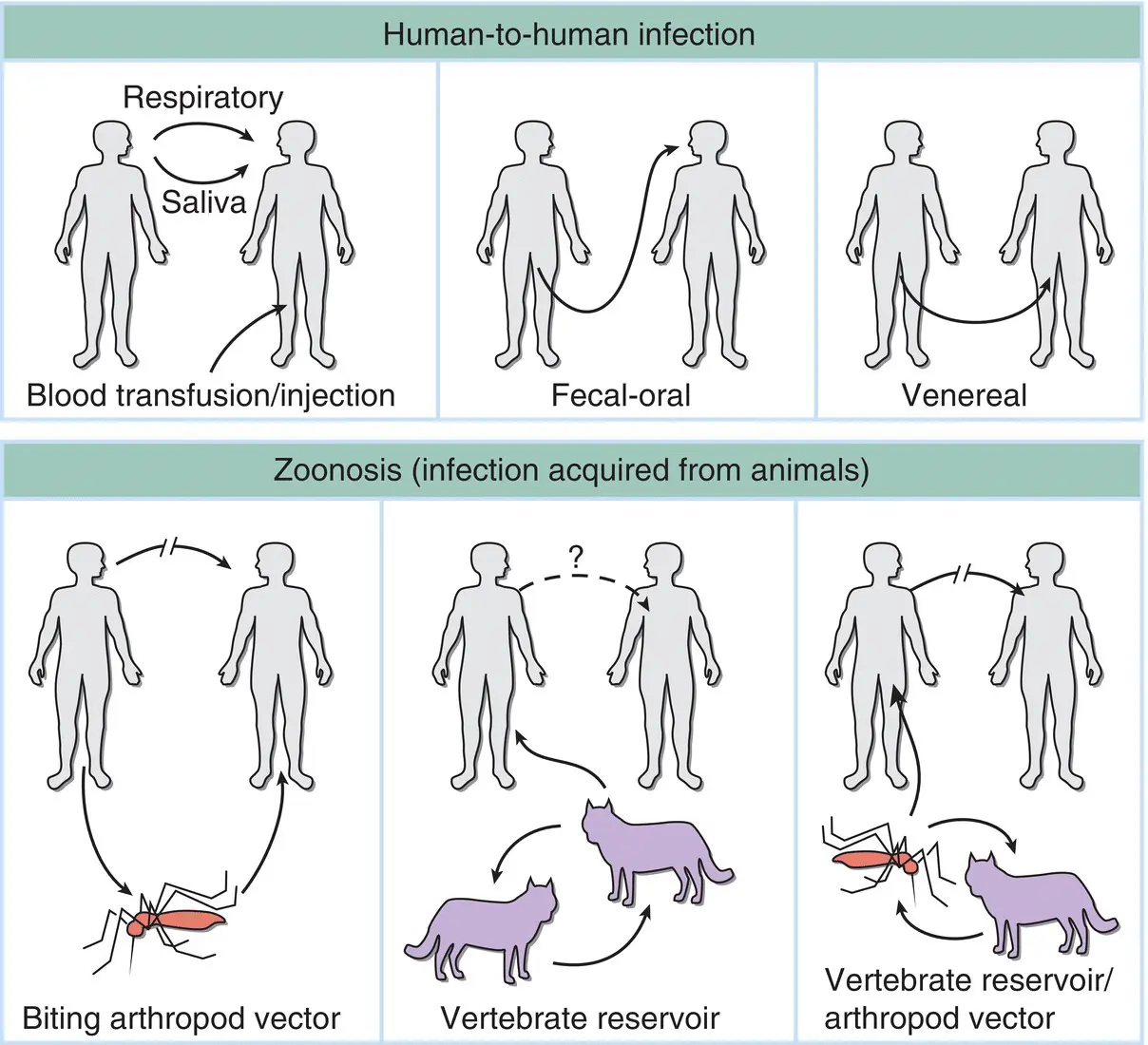CHAPTER 3 Virus Disease in Populations and Individual Animals
THE NATURE OF VIRUS RESERVOIRS
Some viruses with human reservoirs
Some viruses with vertebrate reservoirs
VIRUSES IN POPULATIONS
Viral epidemiology in small and large populations
Factors affecting the control of viral disease in populations
ANIMAL MODELS TO STUDY VIRAL PATHOGENESIS
A mouse model for studying poxvirus infection and spread
Rabies: Where is the virus during its long incubation period?
Herpes simplex virus latency Murine models Rabbit models Guinea pig models
QUESTIONS FOR CHAPTER 3
THE NATURE OF VIRUS RESERVOIRS
Since viruses must replicate to survive, actively infected populations are the usual source of infection. Still, some viruses such as poxviruses, noroviruses, and coronaviruseshave a high resistance to desiccation. In this case a contaminated object such as a desk, pen, book, contaminated clothing, or other inanimate object can be identified as the immediate reservoir. The persistence of some viruses in fecal material is also a potentially long‐lasting, essentially passive reservoir of infection. Noroviruses, which are notorious for causing outbreaks of diarrhea on cruise ships and in nursing homes, are extremely difficult to eliminate from these facilities after an outbreak. Other viruses can even persist for long periods of time in arid environments. The last documented cases of smallpox in Somalia were apparently acquired from contaminated soil. Aerosols of infectious hantavirusand canine parvoviruscan be infectious for many months after secretion. Also, some viruses, especially hepatitis A virus, can be isolated from contaminated water sources for several days or even weeks after inoculation.

Figure 3.1Some transmission routes of specific viruses from their source (reservoir) to humans. The mode of transmission (vector) is also shown.
Source: Based on Mims, C.A. and White, D.O. (1984). Viral Pathogenesis and Immunology . Boston: Blackwell Science.
Even though infectious virus can sometimes be maintained for a time in the environment in a passive state, viruses are more commonly transmitted via contact with an infectious host. The two most usual reservoirs for human disease are other humans or other animals ( zoonosis). Often this transmission requires direct contact between hosts, or may involve an intermediate vector such as a mosquito or tick; modes of spread of some human viruses are illustrated in Figure 3.1, and pathogenic viruses and their reservoirs discussed in this section are listed in Table 3.1.
Some viruses with human reservoirs
A significant number of human viruses leading to either mild or life‐threatening disease are maintained solely in human populations. The list runs the gamut from colds caused mainly by rhinoviruses, warts caused by papillomaviruses, to AIDS caused by HIV. The mode of passage of viruses between humans (i.e., the vector) is intimately linked to human behavior. This behavior can be modified by the disease symptoms themselves. Thus, a respiratory infection leads to irritation of the airways resulting in coughing and sneezing, which spreads an aerosol of droplets containing virus. Herpes simplex virus 1 (HSV‐1) is spread in saliva resulting in transfer of the virus to the recipient's oral epithelial cells; in contrast, the closely related varicella zoster virus (VZV, or chickenpox) is spread by inhalation of a virus‐loaded aerosol or dust containing dead skin flakes. Warts are spread by direct physical contact between the virus‐loaded source (another wart or dead skin from a wart) and layers of the skin below the keratinized epidermis exposed by small cuts or abrasions. Poliovirus and the related coxsackieviruses are spread by virus‐containing feces contaminating food, drinks, or fomites that are ingested; this is termed oral‐fecal spread . In the case of HIV, body fluids – including blood, breast milk, serum, vaginal secretions, and seminal fluid – are sources of infection. The virus can be spread by passive inoculation of, for example, a contaminated hypodermic syringe, or by transfusion, breastfeeding, or sexual activity.
Table 3.1Some pathogenic viruses, their vectors or routes of spread, and their hosts.
| Virus |
Vector/Route |
Host |
Disease |
| Poliovirus |
Human–fecal contamination of water or food |
Human |
Enteric infection; in rare cases, CNS infection (poliomyelitis) |
| Western equine encephalitis |
Mosquito |
Horse |
Viral encephalitis in the horse – occasional infection of human |
| La Crosse encephalitis |
Mosquito |
Squirrel, fox (reservoir); human |
No obvious disease in squirrel or fox; viral encephalitis in human |
| Sin Nombre virus (hantavirus) |
Deer mouse |
Deer mouse, other rodents (reservoir); human |
Hantavirus hemorrhagic respiratory distress syndrome |
| HIV |
Direct injection of virus‐infected body fluids into blood |
Human |
AIDS |
| Measles |
Aerosol |
Human |
Skin rash, neurological involvement |
| Yellow fever |
Mosquito |
Tropical monkeys; human |
Malaise, jaundice |
| Chikungunya |
Mosquito |
Human, primates |
Mild to severe hemorrhagic and arthritic disease |
| Dengue fever |
Mosquito |
Human, primates |
Mild to severe hemorrhagic disease |
| Ebola |
Unknown vector, but nosocomial transmission |
Fruit bat; humans and primates |
Often fatal hemorrhagic fever |
| Hepatitis A |
Fecal contamination of water or food |
Human |
Acute hepatitis |
| Hepatitis B |
Direct injection of blood |
Human |
Chronic hepatitis, liver carcinoma |
| Hepatitis C |
Direct injection of blood |
Human |
Acute and chronic hepatitis |
| Hepatitis delta |
Blood, requires coinfection with hepatitis B |
Human |
Acute hepatitis |
| Hepatitis E |
Fecal contamination of water or food |
Human |
Mild acute hepatitis, except often fatal to pregnant women |
| Norovirus |
Fecal contamination of water or food |
Human |
Severe diarrhea |
| Rabies |
Bite of infected animal |
Vertebrates |
Fatal encephalitis |
| Herpes simplex virus (HSV) |
Saliva, other secretions |
Human |
Surface lesions followed by latency, rare encephalitis |
| Varicella zoster (VZV, or chickenpox) |
Aerosol, infected skin cells (dander) |
Human |
Rash, shingles, latency |
| Epstein–Barr virus (EBV) |
Saliva |
Human |
Infectious mononucleosis, latency |
| Influenza |
Aerosol |
Human, many vertebrates |
Flu |
| Myxoma |
Insect bite |
Rabbits |
Variable mortality, skin lesions |
| Rhinovirus |
Aerosol |
Human |
Colds |
| Coronavirus (CoV) |
Aerosol |
Civet cat (SARS‐CoV); camel (MERS‐CoV); human |
Colds, SARS, MERS, COVID‐19 |
| Rubella (German measles) |
Aerosol |
Human |
Mild rash, severe neurological involvement in first‐trimester fetus |
| Adenovirus |
Aerosol, saliva |
Human |
Mild respiratory disease |
| Papillomavirus |
Contact |
Human |
Benign warts, some venereally transmitted, some correlated with cervical carcinomas |
| HTLV (human T‐cell leukemia virus) |
Injection of blood |
Human |
Leukemia |
| Tomato spotted wilt (bunyavirus) |
Thrip |
Broad range of plant species |
Necrosis of plant tissue, destruction of crops |
| Cadang‐cadang (viroid) |
Physical transmission via pruning |
Coconut palm |
Coconut palm pathology |
| Prion (protein pathogen) |
Ingestion or inoculation of prion protein |
Human, other mammals have specific types, cross‐species spread possible |
Non‐inflammatory encephalopathy |
| Plant rhabdoviruses |
Leaf hoppers, aphids, plant hoppers |
Broad range of plant species |
Necrosis of plant tissue, destruction of crops |
| Zika virus |
Mosquito |
Human, primates |
Mild to severe disease, microencephaly, Guillain–Barré syndrome |
Some viruses with vertebrate reservoirs
Читать дальше













